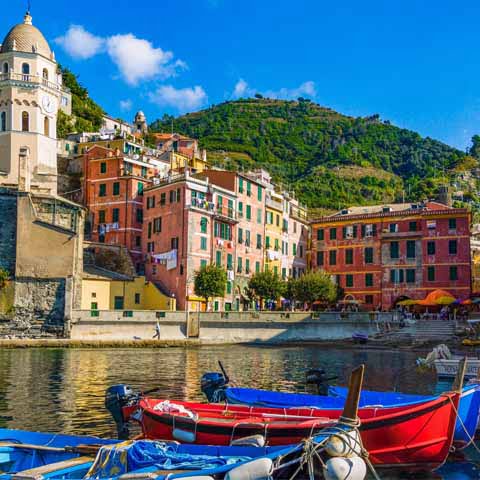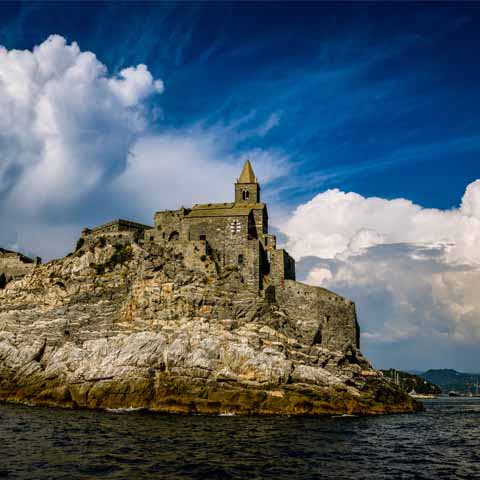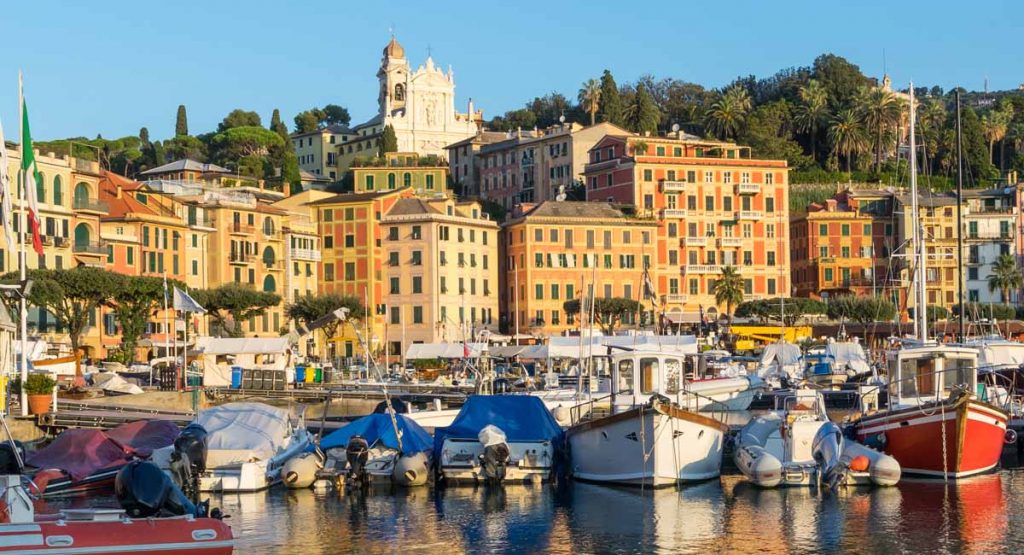The Cinque Terre area is one of the most evocative places on the Italian coastline, a cultural space like no other that impresses with its rugged yet incredibly beautiful territory. It consists of five villages located in a harsh environment, on the steep slopes of stone cliffs overlooking the Mediterranean Sea.
The area gets its name from the number of villages it contains. Indeed, Cinque Terre translates to Five Lands, and as a whole the area dates back to the 11th century. Nevertheless, the history of the region is much older than this.
Historic remains found here, including bones and primitive tools, prove human presence in the area since prehistoric times. The Cinque Terre area is thought to have been inhabited by the first Ligurian tribes, then conquered by the Romans through harsh conflicts and hostile wars in their attempt to gain land with such a strategic position on the Mediterranean.
Then, the villages had to face the anger of ruthless populations and diverse empires, from the barbaric tribes to the Lombards, French, and Spaniards.
Due to its tactical location from a commercial and military standpoint, the settlers of the villages, most likely immigrants from Val di Vara, began to settle on the coast and change the appearance of this naturally wild and belligerent area. Building terraces and starting to cultivate the land, these people grouped into the five villages that make up the area today. The peculiarity is that although these villages share a common history, each settlement also has a history of its own.
Monterosso dates back to the Roman times, but its oldest core located on the hill of San Cristoforo only began to play a significant role in the seventh century, during the Lombard attacks. The area was disputed between many noble families in the Middle Ages; then it was conquered by the Republic of Genoa.
Spreading on the two banks of a former stream, Monterosso consists of an old town located on the eastern side and a more modern development on the western side, that also includes the railway station and other important facilities.
Vernazza has an older history than Monterosso. It was formed by a group of people already settled on the heights of the Reggio Hill. After the Roman conquest, the settlers migrated towards the coastline and founded the village.
Vernazza became an important harbor during the middle ages, ruled primarily by the noble families of Ponzo, Da Passano, and Fieschi. Following the fate of Monterosso, Vernazza also fell under the domination of the Republic of Genoa in 1276.
The importance of this village in the history of the Liguria region is highlighted by its urban arrangement consisting of typical tower-shaped dwellings that, just like in the case of Monterosso, extend along the valley of a river, rising up on the summit of a rocky outcrop. This natural position hides the core of the village from anyone approaching by sea.
Corniglia, the third of the five villages, was also founded during the Roman age, but unlike Vernazza, there is no evidence of an earlier settlement. The name of the village most likely derives from Gens Cornelia, a wealthy Roman family who allegedly owned the land.
Just like its sisters, this village was ruled by many noble families in the Middle Ages; then it was conquered by the Republic of Genoa.
Manarola, the fourth of the five lands, is located in the immediate proximity of Riomaggiore, but it is much more ancient. It is not certain whether the first urban core has pre-Romanic origins, but its name derives from Manium Arula, which means the altar of the Mani gods.
Abandoned during the Middle Ages, the village was repopulated in the twelfth century by immigrants from a nearby village located higher on the cliff. Just like the other three, it was first ruled by local noble families; then it passed under the Republic of Genoa in 1276. Arranged on the banks of a stream, the village is partially grouped on a rocky outcrop and partially aligned to the stream along the valley.
The last village, Riomaggiore, is the only one that doesn’t have Roman origins. In fact, it is believed that it was only founded in the seventh century, much later compared to its other four counterparts. Some evidence suggests that it was founded by a group of immigrants from the nearby village Montenero, located further up on the hill.
Following the history of the other four villages, Riomaggiore was first ruled by the nobles, then conquered by the Republic of Genoa.
So different and yet so similar, the villages and the land on which they emerged share a rich common history.
PREHISTORY OF CINQUE TERRE
The first evidence of human presence in the area of Cinque Terre and its surroundings is attested since the Paleolithic era. Some deposits that suggest the presence of early settlements were found at Grotta dei Colombi, where the remains of animal burials, bones, flint artifacts, and fossils suggest the rise of the first civilizations in the region.
Remains from the Neolithic era also suggest the interest of the early populations in the region, as shown by some primitive axes, indicating that the area was inhabited by hunters who may have had either a permanent or temporary settlement in the caves and rock shelters on the steep slopes. Hunting probably represented a primary subsistence resource for millennia, perhaps until the Roman times. Surviving over the centuries are menhirs found in the area of Campiglia Tramonti. According to some historians, these stones could have been either a place of worship or might have had a function related to the calendar.
The first Ligurian tribes arrived in the area during the Bronze Age, settling in small villages known as Castellari due to their dominant position and prevailing defensive function. One of these early villages is Mount Castellaro, located near Cinque Terre. Excavations here have brought to light a considerable number of artifacts, including fragments of decorated vases – a clear indicator of a stable and important settlement. The Romans arrived in the region during the Augustan Age, and their military chronicles testify how the local tribes represented a strong obstacle to the Romanization of the territory. In fact, the Romans settled and concentrated their activity in the Val di Magra initially. Later on, it is believed that part of the Ligurian populations abandoned the settlements on the summits to join the Roman colonists. There is no material or documentary evidence that demonstrates the possible Roman origin of the villages of Cinque Terre as we know them today. Nevertheless, the Latin origin of some of their names suggests that the ancient prehistoric coastal road was used by the Romans and that they gave rise to these settlements, or at least contributed to their development.
HISTORY OF CINQUE TERRE
The villages of the Cinque Terre gained their current structure between the eleventh and twelfth centuries when the populations of Val di Vara surpassed the coastal chain that separated the valley from the sea and settled permanently on the coast, grouping in the five villages. The oldest official document that attests to the formation of Cinque Terre dates back to March 1056, showing that the first village to be established was Monterosso, to which the local marquis donated the monasteries of Santa Maria and San Venerio, as well as lands on the islands of Palmaria, Tinetto, Tino, and in Porto Venere.
This whole migratory phenomenon might seem awkward, because historically speaking, most settlements in the area developed on the same land where the first proto-urban nuclei had been settled by the primitive civilizations. However, the phenomenon is linked to two historical events concerning all of Europe in the era, the demographic increase in most regions and the temporary attenuation of the Saracen threat. Besides these events, the coastline also enjoyed a milder climate, which allowed the cultivation of vines and olives.
In fact, the villages of Cinque Terre were not born as fishing villages, but as agricultural settlements in a territory that was not naturally suited for agricultural practice. This explains the terracing of the slopes that give the characteristic aspect to this enchanted land. Naturally though, as the mountaineers got accustomed with the sea, they became more and more familiar with the marine element. They first started to use the sea as a faster and more effective communication route with the surrounding villages. Then, the sea became a source of sustenance. As such, the population divided its activities between agriculture and fishing, according to the needs and seasons.
Vernazza, above all, gained a lot of power and influence thanks to its natural port, enough to ally with Genoa in the war against Pisa in 1170. But this alliance didn’t last for long, and merely twelve years later, Vernazza started to engage in wars against Genoa. After decades of struggle, the village finally succumbed to Genoa in 1276, alongside all other villages in Cinque Terre.
From now on, the history of the Cinque Terre area is closely linked to the history of the Republic of Genoa and the rest of the Ligurian territory. History doesn’t mark any exceptional events in the area, apart from sporadic attempts of conquest by the Turkish pirates in the fifteenth century. Indeed, as it happened along the entire Tyrrhenian coast, the constant danger of Turkish incursions terrorized the population of the coastal areas. During this time, numerous watchtowers and other defensive structures were built. The Cinque Terre villages also received their defensive buildings, including the watchtower erected on the summit of Mount Mesco in Monterosso and on the summit of Montenero in Riomaggiore. These communicating towers were primarily used during the night, signaling the foreign incursions with the help of fire.
Despite the existence of these towers, the Turks still managed to conquer Cinque Terre in 1545, deporting slaves from Monterosso and Corniglia. The other villages, above all Manarola and Riomaggiore, allied and managed to reject the incursion. Nevertheless, the area struggled with the Islamic attacks for the following centuries, until 1815. Apart from their defensive role and intermittent attacks, the villages followed the history of the entire region and the Republic of Genoa.
In 1997, Cinque Terre was declared a World Heritage Site by UNESCO, and from 1998, it was established as a protected marine area for the preservation of its biodiversity as well as the naturalistic relevance of the landscape. Since 1999, the Cinque Terre National Park safeguards the ecological balance and anthropological value of the area.
ARCHAEOLOGY IN CINQUE TERRE
The area surrounding Cinque Terre is extremely rich in archaeological evidence that shows traces of human presence in the area since the Paleolithic Era. However, these remains are not concentrated exactly in the area of the villages. Their names suggest a potential Roman origin; yet again, there is no solid evidence from the Roman Era. Artifacts found in the area are now housed in various archaeological and history museums in La Spezia, Porto Venere, Pieve di Zignago, and Genoa.
Travel Guides
The Liguria Region of Italy
The Cities of Liguria, Italy






